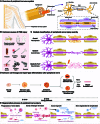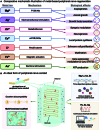Metal-Based Regenerative Strategies for Peripheral Nerve Injuries: From Biodegradable Ion Source to Stable Conductive Implants
- PMID: 40697648
- PMCID: PMC12280558
- DOI: 10.34133/bmr.0219
Metal-Based Regenerative Strategies for Peripheral Nerve Injuries: From Biodegradable Ion Source to Stable Conductive Implants
Abstract
Peripheral nerve injury is a common health issue in modern aging societies, with the only treatment available being autograft transplantation. Unfortunately, autograft is often limited due to donor availability and immune rejection. Additionally, the peripheral nervous system has limited regenerative capacity, making the treatment of peripheral nerve injuries challenging. Metal-based regenerative medicine and tissue engineering strategies provide advanced solutions to the problem. Metal-based biomaterials such as conduits, filaments, alloys, hydrogels, and ceramics can deliver biofunctional metal ions and promote axonal growth and functional recovery. In parallel, metal-based electromagnetic stimulation demonstrates potential for nerve regeneration and inflammation regulation. The potential of metal-based biomaterials in promoting peripheral nerve regeneration highlights the need for further research in tissue engineering and regenerative medicine. However, rapid degradation, long-term biocompatibility, and necessary optimization regarding injury types remain to be explored. This review summarizes the reported metal-based biomaterials utilized in peripheral nerve regeneration research. The aim is to showcase advanced technologies available in the field, which may potentially become a viable alternative to autografts, offering transformative applications in the regenerative medical field.
Copyright © 2025 Hyewon Kim et al.
Conflict of interest statement
Competing interests: The authors declare that they have no competing interests.
Figures




Similar articles
-
Bioengineered nerve conduits and wraps for peripheral nerve repair of the upper limb.Cochrane Database Syst Rev. 2022 Dec 7;12(12):CD012574. doi: 10.1002/14651858.CD012574.pub2. Cochrane Database Syst Rev. 2022. PMID: 36477774 Free PMC article.
-
Management of urinary stones by experts in stone disease (ESD 2025).Arch Ital Urol Androl. 2025 Jun 30;97(2):14085. doi: 10.4081/aiua.2025.14085. Epub 2025 Jun 30. Arch Ital Urol Androl. 2025. PMID: 40583613 Review.
-
Short-Term Memory Impairment.2024 Jun 8. In: StatPearls [Internet]. Treasure Island (FL): StatPearls Publishing; 2025 Jan–. 2024 Jun 8. In: StatPearls [Internet]. Treasure Island (FL): StatPearls Publishing; 2025 Jan–. PMID: 31424720 Free Books & Documents.
-
Sexual Harassment and Prevention Training.2024 Mar 29. In: StatPearls [Internet]. Treasure Island (FL): StatPearls Publishing; 2025 Jan–. 2024 Mar 29. In: StatPearls [Internet]. Treasure Island (FL): StatPearls Publishing; 2025 Jan–. PMID: 36508513 Free Books & Documents.
-
Scaffold design considerations for peripheral nerve regeneration.J Neural Eng. 2024 Jul 23;21(4):10.1088/1741-2552/ad628d. doi: 10.1088/1741-2552/ad628d. J Neural Eng. 2024. PMID: 38996412 Free PMC article. Review.
References
-
- Murphy RNA, Schoulepnikoff C, Chen JHC, Columb MO, Bedford J, Wong JK, Reid AJ. The incidence and management of peripheral nerve injury in England (2005–2020). J Plast Reconstr Aesthet Surg. 2023;80:75–85. - PubMed
Publication types
LinkOut - more resources
Full Text Sources

